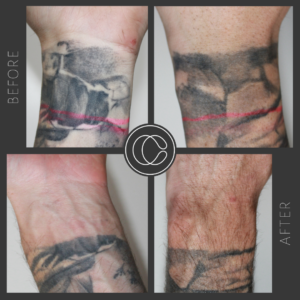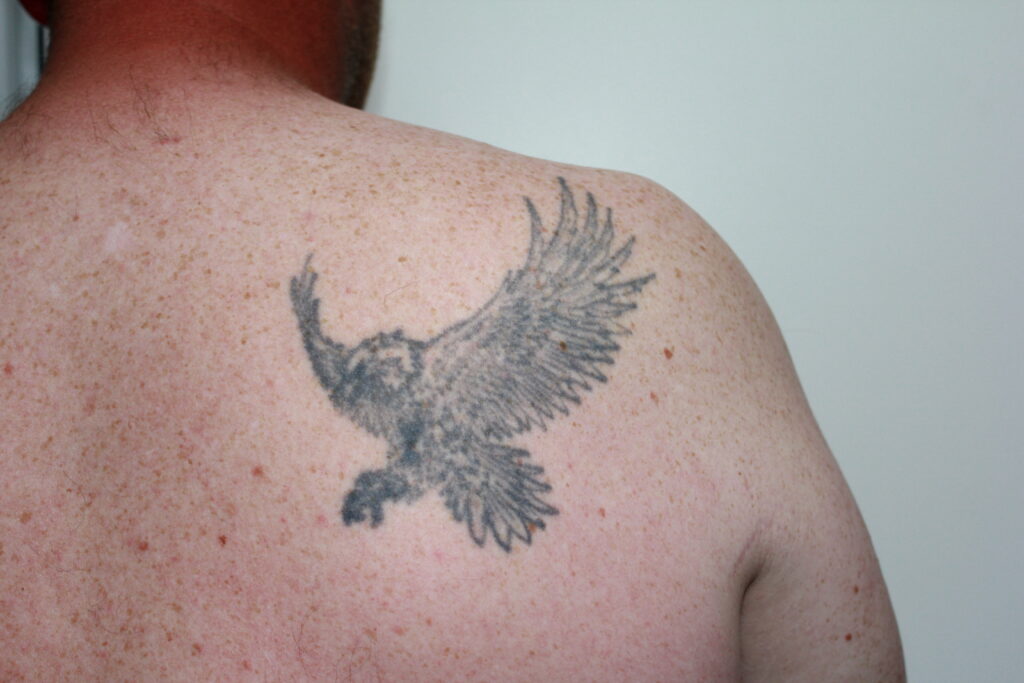Tattoos have become increasingly popular over the years. More and more people are decorating their skin with ink—but what happens when you want it gone?
There are so many reasons why you might want to remove a tattoo. Maybe it’s a poor-quality tattoo. Maybe it’s something that no longer resonates with you. Or maybe it commemorates something embarrassing you’d rather not remember—like dating your ex.
If you’ve been considering getting laser tattoo removal, here’s what you’ll want to know.
How does laser tattoo removal work?
Laser is one of the safest and most reliable ways to remove a tattoo.
It works by firing concentrated beams of light through the skin, and onto the tattoo ink pigment. This breaks the pigment down into smaller particles, which are carried away as waste in the bloodstream.
It’s also affordable, although the cost varies depending on the size and depth of the tattoo, as well as how many treatments are required. It’s no wonder laser is the most popular way to remove tattoos.
What kinds of tattoos can be removed?
Most laser tattoo removal clinics can remove decorative (both amateur and professional), medical tattoos applied to patients of radiation therapy, scalp micro-pigmentation and cosmetic tattoos.

Can I get a partial tattoo removal?
Yes, if there is only a small part of a tattoo that you want removed then most clinics are able to focus on that part and leave the rest.
How do I know if I’m a suitable tattoo removal candidate?
It’s very important that before you book any procedures you have a consultation first to ensure that your tattoo is suitable for removal.
Some common factors that may affect your suitability for tattoo removal includes:
- Blood or healing disorders
- Medications being consumed that are light sensitive
- Tanning on the treatment area
- Long term health issues, for example, epilepsy.
In most cases, if you are generally in good health, then you would be considered eligible to proceed.
Does laser tattoo removal hurt?
We won’t lie to you – it’s definitely not painless however most people describe the sensation as a rubber band being flicked onto the skin over and over again. We like to say, if you could handle getting the tattoo in the first place, you can handle getting it removed!
While it isn’t an overly pleasant feeling, there will usually be ways your clinician can make the experience less painful. These include using a cooling device before the treatment or topical anaesthetic.
Is tattoo removal safe?
Tattoo removal is so much more than just knowing about tattoos. It’s important that your clinician is highly trained in skin response, contra-indications and how your overall health can impact the success of your removal. Ensure that you are dealing with someone that can keep you well informed on how to get the most out of tattoo removal treatment.
Our PicoWay treatments selectively treat the tattoo while leaving the surrounding skin undamaged. Its ultrashort picosecond pulses allow for effective treatments with minimal risk of side effects. Its photoacoustic energy delivery means that there is significantly less heat generated, reducing the risk and providing clearance in fewer treatments.
Does tattoo removal cause cancer?
No. Laser tattoo removal is performed using laser light. This is a non-ionising form of radiation, meaning that exposure to it does not cause cell mutation or cell death. It has been used safely in dermatology for over 3 decades.
How do I prepare for my session?
Preparation for tattoo removal is just as important as post-treatment care. In order to begin treatment you must ensure:
- The treatment area has been protected from direct sun exposure for at least 4 weeks prior to treatment
- You have not used tanning beds, applied self tan or been injected with melanin for at least 8-12 weeks prior to treatment
- You consult with us about any medications or contra-indications that could interfere with your treatments
How many sessions will I need to remove my tattoo?
Every tattoo and every skin is different so your tattoo removal process will differ from someone else’s.
Your type of tattoo – be it amateur or professional – its size, depth, type and colour of ink are all factors in the number of treatments you will require. The location of your tattoo can also play a role, together with your overall immune health.
Most laser tattoo removal treatments take approximately 5-10 sessions and your clinician will advise you on how long yours might take.
How long between treatment sessions?
Time between tattoo removal treatments is recommended to be 6-8 weeks. This gives your immune system the best chance of removing those minuscule ink particles, giving you the best possible fading between treatments. It also means we won’t be treating the same ink particles more than once which will likely see you require fewer treatments throughout the whole process.
The good news is that by choosing Clean Canvas and our PicoWay device, fewer overall treatments are required, meaning we are able to treat you faster than most other laser devices.
Does tattoo removal have side effects?
After treatments, some patients may experience temporary discolouration or redness around the treatment area. Other patients may also experience temporary lightening of the skin. The skin will typically resolve to its normal tones within a few months of the last treatment.
There is minimal risk of scarring due to the picosecond pulses of our device. Thermal (heat) effects are reduced significantly and the Resolve fractional capabilities of our PicoWay device actually assist in scar tissue reduction.
Providing that you follow your post-treatment care instructions carefully, the chances of any adverse effects are minimal.
Can I receive treatment if I’m pregnant?
There is not enough evidence to suggest one way or the other that harm can come to the mother or foetus from laser tattoo removal during pregnancy, however we recommend that treatment be postponed until post-pregnancy and when breastfeeding has ceased. Immunity is generally lower during pregnancy and hormonal changes are known to cause other pigmentation skin conditions like melasma. Ink removal relies on your immune system, therefore our preference is to treat whilst it’s at its highest capacity.
Laser tattoo removal aftercare
Just like any medical procedure, you will receive aftercare instructions to ensure the best outcome of your treatment.
Common laser tattoo removal aftercare instructions include:
- Keeping the area clean after every session.
- Avoid exposure of the treated area to hot water or workouts that will induce heat in the skin, particularly for the first 24 hours. You may shower, however use only mildly warm water on the treated area and avoid scrubbing.
- Continue to apply ointment to the treated area for 2-3 days post-treatment.
- Avoid sun exposure.
- Avoid direct contact with the treated area that may cause injury to it, particularly scratching, picking or aggressive washing.
- Refrain from using makeup in the unlikely event that you experience broken skin on the treatment area until it is fully healed.
Choose Clean Canvas Laser Clinic- the laser tattoo removal professionals
We’re certified in laser tattoo removal and highly trained in skin type, skin response & device parameters to achieve maximum results whilst leaving your skin unharmed and scar free.
If you’re looking for a laser tattoo removal clinic in Sydney, get in touch today!
